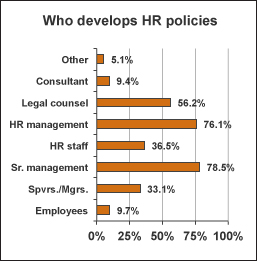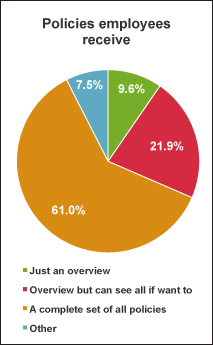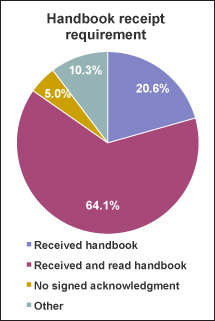The results of BLR’s 2014 Policy Practices Survey are in; here are some highlights:
- 89.8% of participants have formalized policies.
- 77.5% have an at-will employment statement.
- Employee handbooks are the preferred method of distributing policies to employees for 49.9%. An internal website (intranet) is utilized by 29.3%.
- Social media background checks are conducted by only 14.7% of respondents; top sites are LinkedIn (67%), Facebook (60.8%), and Google (34.5%).
Policy Development
Down from 84% last year, policy development falls in the lap of HR management for 76.1% of the survey participants that answered this question. Senior management involvement is up, however, with 78.5% participating in 2014 versus 54.1% in 2013. Outside legal counsel has a hand in the process for 56.2% this year compared to 24.6% in 2013. Rounding out the group is supervisors/managers for 33.1% (9.4% in 2013) along with employees at 9.7%. Consultants are involved in policy development for 9.4% (5.9% in 2013) and the 5.1% indicated for “other” includes policy committees and union contracts as well as boards of directors.
For organizations that use outside resources other than legal counsel, 54% (60.9% in 2013) use information from trade associations to develop their policies. Also, 39.9% (43% in 2013) use government resources, and 46.2% (37.5% in 2013) use commercial vendors. Using HR consultants to develop policies trails the group with 26.3% (24.4% in 2013).
Senior management has final approval of policies for 63.7%. Legal counsel has final approval for 11.4% of survey participants that answered the question, and HR management has approval for 11.8%.

Finally, a simple but comprehensive guide to wage and hour. Correctly apply the FLSA, remain the go-to expert with BLR’s comprehensive guide. Save hours of research time. Go here for information or to order Wage & Hour Compliance: Practical Solutions for HR
Policy Implementation
When asked how often policies are updated, 48.2% (45.4% in 2013) of survey respondents indicate they update policies as needed and 23.9% (27.3% in 2013) state they update policies annually.

Policies Are Specific to …
Though some policies are specific to employees based on their FLSA classification (exempt/nonexempt) for 42.3%, all policies apply to all employees for 47.8% (61.9% in 2013). Breaking this down further, some policies are specific to either office or production employees for 18.8%, and some are specific to department, location, or worksite for 27.1%.
No language translation is provided by 87.2% of participants. Handbooks are translated into Spanish, however, by 5.8%, into other languages by 1.4%, and translated into Spanish as well as another language by 1.6%.
Policy Distribution
Employee handbooks are the preferred method of distributing policies to employees for 49.9% (55.4% in 2013). An internal website (intranet) is utilized by 29.3% (35.4% in 2013) and e-mail is the distribution vehicle for 6.7% (10.5% in 2013), while 2.8% distribute their policies via loose-leaf memo, and 1.9% do not distribute handbooks or written policies to employees. “Other” included some interesting responses, including:
- Group meetings
- One-on-one meetings
- Learning management system
- Posted on bulletin board, notice board
- Paycheck stuffer
- Shared drives
- Employee newsletter
Some are quite thorough when distributing policies to employees. For example:
“As new policies are introduced we have each employee sign the actual policy on a single sheet of paper and it’s filed in their personnel file. The policy is then inserted on our intranet in policies and procedures. Our handbook is updated with general information regarding policy (which is also located on the intranet).”
“At time of hire copies of our policies are provided with the contract and require a signature from the employee that they will abide by the policies.”
“Initially through a handbook, but as policies are revised/developed they are distributed electronically to non-union employees and in paper format to union employees.”
Wage and hour lawsuits are expensive—and easily prevented. Here’s how to protect against crippling judgments. Go here for information or to order Wage & Hour Compliance: Practical Solutions for HR
Just an overview of policies is provided to employees for 9.6%, and 21.9% provide an overview and make every policy available to employees who want to see them. For 61%, however, everyone receives a complete set of HR policies and procedures. Management team members receive a separate policy and procedure manual from the handbooks/policies that employees receive for 22.9% of survey respondents, but management team members do not for 70%.

An employee’s receipt of handbook acknowledgement is required by 84.7% (81.9% in 2013) of survey participants, with 20.6% acknowledging that they received the handbook and 64.1% acknowledging that they not only received it but read it as well. Surprisingly, only 9.97% require employees to turn in outdated handbooks.

For those whose handbooks are online and not printed, 26.1% track employee log-on and require a signed acknowledgement. Another 4%, though, just track the log-on.
In tomorrow’s Advisor, we will present more policy results, plus an introduction to the comprehensive guide to wage and hour.
